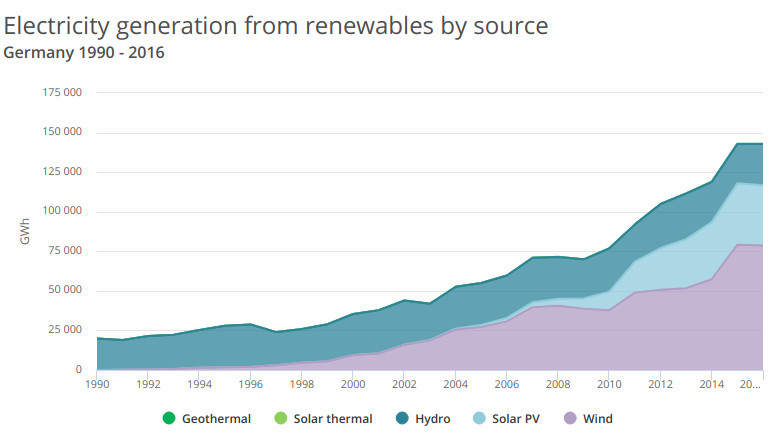Friday for Future is running and I feel the need of making sure (firstly to myself) that the process that will bring us totally away from fossil fuel consumption is possible, maybe long, but possible.
Decarbonization (this is the name given to the biggest revamping project in the world) is possible; will require money and time; will require the mutual work of Politics, Science and Industry toward the goals of :
- producing electricity totally from renewable sources, decentralize prodution
- reducing the energy consumption in all areas were this is possible
- decentralize smart grid and electricity storage development
- substitute direct fossil fuel consumption with renewable alternatives
- stop deforestation process
- substitute fossil fuel derived products with fossil derived recycled ones (or carbon free ones if possible)
- 100 % recycle, waste to energy for the non recyclable
Ambitious plan ? I think this is the biggest revamping project you can immagine and it is already running but I think that the message we all sent last last friday is that we need to ‘deliver’ sooner 🙂
Producing electricity totaly from renewable sources
48 % of CO2 is emitted producing heat or electricity. Many countries are already active in the area of producing electricity from renewables, take Germany for example. 7 year ago (just after fukushima) Germany started phase out of nuclear power by incrementing the share of energy produced by renewables. Some data :

In 1 year Germany increased production from wind energ for example by 20 GWh. Continue this for 10 years and your reach more than half the whole country energy requirements. In fact Germany has also started a plan for removing coal in energy production.
In the first 6 months of 2019 Germany has produced more energy from renewables than from fossile/nuclear : here for some references.
Energy efficency
Again from Germany, a national plan to increase the efficency of systems in all areas which is estimating to produce a saving of 12 to 20% over 2020. Reducing the current energy footprint is fundamental for allowing new segments of activities to start using clean energy (think at electrical traction in automotive which is going to increase national demand)
Decentralize smart grid and electricity storage development
The example here comes form Australia were private energy company GreenSync is stimulating customers to setup local electricity storage to be used when there is shortage of power on the grid. Customers are being paid for the storage. For reason not known to me the biggest development in decentralized grid and storage is taking place in Australia and Japan.
Substitute direct fossil fuel consumption with renewable alternatives, limit impatc of direct CO2 emission
This is probably the biggest task in the project because it is spread over a tens of different segments which need to be revamped to achieve the goal :
Road Transportation : around 15% of total CO2 emissions. Redesigning this segment is going to be one of most serious tasks : cars and trucks make up 1/3 of the co2 emissions in countries like US and it is mostly a consumer segment. Battery powered electric cars, pickups and trucks seems to be the directions with Tesla, the real game changer, paving the road. All automotive industry is trying to catchup. 44 Billion investments announces by Volkswagen group over the next 5 years.
Agricolture : How much CO2 is produced by agricolture is the most controversial issue with estimates ranging from 13% of total CO2 emissions to 18% on fao docs, up to 51% including the effect of not having forests where we make food for cows, pigs and chicken. These comes mainly from Cattle belching (CH4) and the addition of natural or synthetic fertilizers and wastes to soils. Here the only possible change is reducing the use of fertilizers and reduce cattle breeding by eating less meat. Read Jonathan Safran Foer book if you want to dig into this more.
Maritime Transportation : 5% of total CO2 emissions, The world’s merchant fleet consists of around 100,000 ships and these are estimated to consume 250 million tonnes of bunker fuel annually. Just one Capesize Bulk Carrier or Bulker can use 40 metric tonnes or fuel or more a day leading to an annual fuel consumption of approximately 10,400 tonnes. This results in the emission of around 32,988 tonnes of CO2 and 959 tonnes of SOx or more. This is just from one ship. Still no real prototypes afaik in this area but good project and potential around with project like Acquarius.
Air Transportation : 2% to 3.5% of total CO2 emissions . Various activities undergoing reduction of carbon footprint in aviation.
Substitute fossil fuel derived products with fossil derived recycled ones (or carbon free ones if possible)
This is probably the biggest task in the project because it is spread over a tens of different segments which need to be revamped to achieve the goal :
- Plastics
- Lubricants
- Process Chemicals
- Carpeting
- Pharmaceuticals
- Rubber Goods
- Adhesives
- Cosmetics
- Footwear
- Paints
- Detergents
- Inks
- Sealants
- Fragrances
- Solvents
- Caulking
- Compounds
- Fertilizers
- Fibers
- Tires
This point will require a complete structured analysis by its own. International energy agency dedicates a complete section on petrochemicals. They are not easy to replace : recycle will be the solution while Science and Industry find better substitutes.
I’ll stop here at least for now : the message I’m trying to share is that the matter is highly complex and cannot be simplified by just switching off air conditioning or doing these kind of things.
ALL activities have to be done at the same time (thanks Greta for having said this) and Politics IS the driver for all of them.
